PRICES
International fish markets are influenced by growing economic uncertainty. Importers, processors and retailers in the large importing markets are scaling back on purchases, less willing to commit or to enter into any long-term contracts. As a result, prices on many fish products are declining after hitting the highest level ever in March 2011.
Since then, as evidenced by the FAO Fish Price Index, aggregate price levels have declined for many fisheries commodities. However, as usual, the picture is not uniform, with supply constraints moving prices upwards for some species, including tuna, shrimp, tilapia, mackerel and herring. The biggest change in market conditions has been for farmed Atlantic salmon. After a strong 2010 with record price levels, prices crashed in May 2011 and the market still has not settled.
GLOBAL FISH ECONOMY: 2011-2012 OUTLOOK
After an excellent 2010, the current year is expected to be equally strong overall, despite the prevailing nervousness in many markets. Prices of some products and species will certainly soften, but the cause is more often to be found on the supply side rather than lack of demand. The underlying demand for fish and fishery products is strong and the stagnation seen in some traditional importing countries in consumption and imports is being compensated by buoyant demand in emerging markets in Asia, Africa, the Middle East, and South and Central America. Outlook for 2012 is more uncertain, but consistent demand increases in the developing world are boosting domestic and regional production and also fostering exports from developed to developing countries, contrary to the traditional direction of a trade that has normally seen developing countries supplying the developed economies.
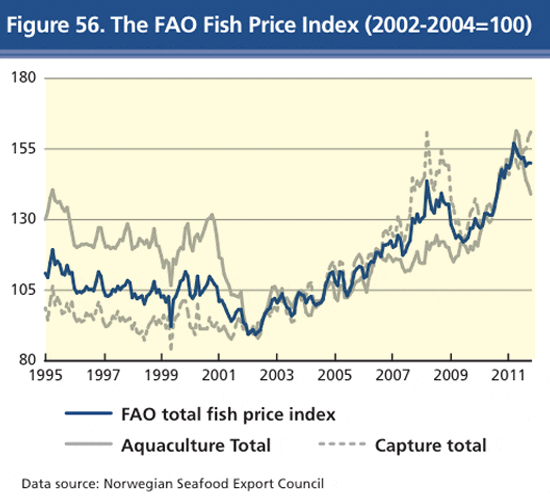
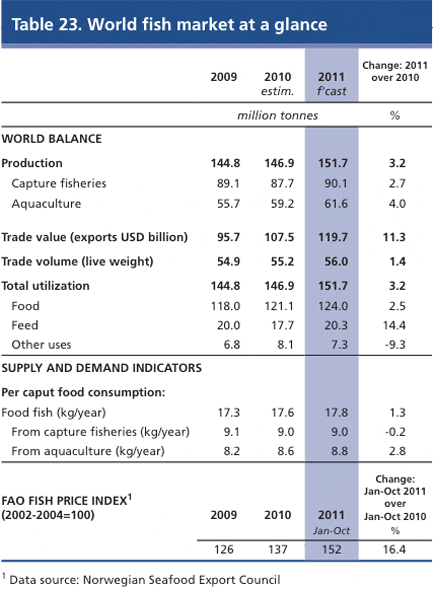
GOOD DEMAND FOR SHRIMP DURING FIRST HALF OF 2011, DESPITE LOWER SUPPLY AND FIRMING PRICES
The major markets, the EU, Japan, and the United States, imported more shrimp during 2011, despite the higher prices caused by the lower than expected Asian supply. Demand for processed shrimp increased in the post-tsunami Japanese market as well as in the EU and the United States, confirming the positive broad-based market trend for value- added shrimp. The strong demand could soften if consumer sentiment turns negative, as shrimp consumption often depends on away-from-home dining and is sensitive to the economic climate.
During the first half of the year, Thailand exports fell back due to raw material constraints, whereas China, India, Indonesia and Viet Nam all saw exports grow. Regional demand for shrimp in many Asian markets remained buoyant, supported by strong national currencies and rising consumer income, even in India which is not traditionally a large market for fishery products. The growth of domestic consumption in developing countries is underpinning local aquaculture development and reduces industry exposure to sudden swings in international markets.
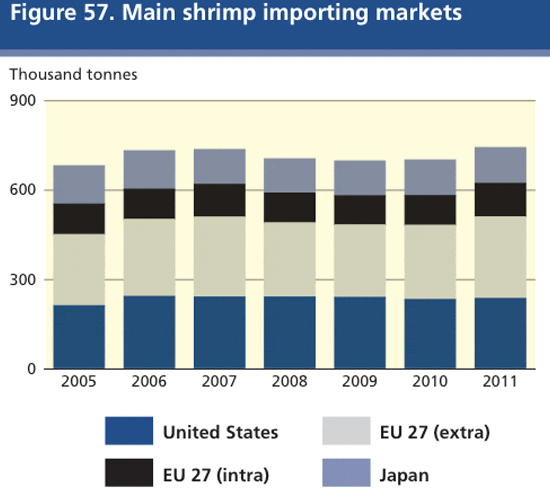
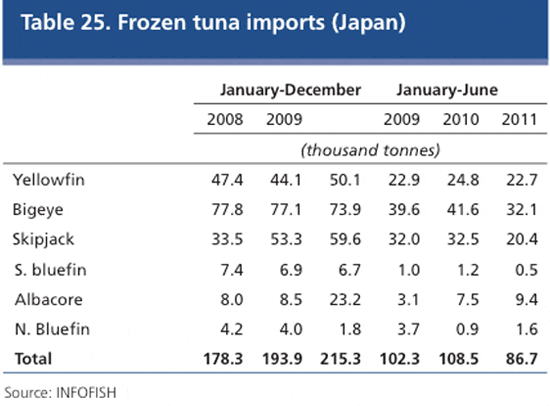
TUNA: RISING PRICES AND THE INDUSTRY UNDER ATTACK BY ENVIRONMENTALISTS
Skipjack raw material price reached an historic high level in September 2011, being quoted at USD 2100 per tonne, cost and freight (CFR), Bangkok, surpassing the previous record set in 2008. Canners are concerned about consumer resistance under the current economic situation in Europe and the United States. Yellowfin raw material for canning has surpassed USD 3,000/tonne in Asia/Pacific because of slow catches. Canned tuna has been under attack in the United Kingdom and the United States by non-governmental organisations (NGOs) who advocate pole-and-line caught tuna, without use of fish aggregating devices (FADs). In Japan, after austerity measures in the spring, sashimi tuna consumption improved during the summer holidays and heightened in mid-August. The Unites States non-canned tuna market remains price sensitive.

TOTAL GROUNDFISH SUPPLY EXPECTED TO IMPROVE BY 4per cent THIS YEAR AS MOST STOCK REMAIN HEALTHY
The outlook for groundfish in 2012 is promising. Based on the latest survey in the Barents Sea, Russian Federation and Norway agreed to increase their joint quota of North East Arctic cod by seven per cent to 751,000 tonnes for 2012. Their haddock quota will increase by 5 per cent to 318,000 tonnes, and Greenland halibut by 20 per cent to 18000 tonnes. Overall, the EU import dependency of whitefish imports is growing, now estimated by the European Union Fish Processors and Traders (AIPCE-CEP) at 89 per cent of consumption, while the overall average level for fish imports is 62 per cent.
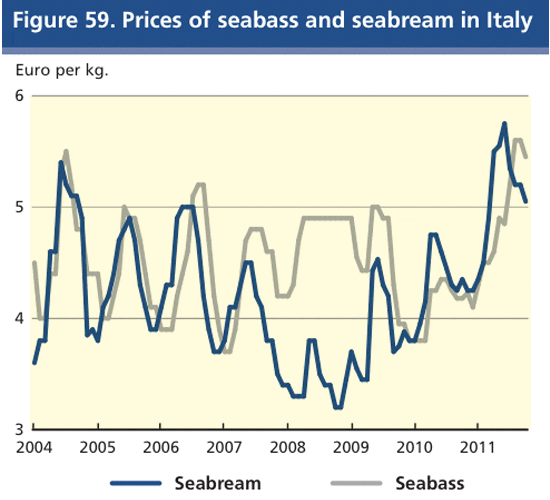
In the United States, the new sector management system in New England for the groundfish fleet seems to be working for cod, haddock, flounder and pollock, with 10 per cent more revenue generated.
Surimi production lower than expected after disappointing Alaska pollock catchesEarly predictions, based on increased quotas for Alaska pollock and hake, and anticipating a good supply of surimi have not materialized. Pollock surimi production is likely to increase by only 28 per cent to 135 000 tonnes in 2011, which is only half the expected increase, and hake surimi production is likely to drop. These expectations are also influenced by lower output from South America, with surimi production from hake, hoki and whiting in Argentina and Chile likely to decline 50 per cent, to less than 10 000 tonnes.
Iceland: cod stocks reaching higher levels of biomassIceland’s Marine Research Institute reports stronger cod stocks and a quota of 177,000 tonnes for 2011–2012, an increase of 10 per cent. Iceland’s haddock quota has been reduced 11 per cent to 40 000 tonnes, and its pollock quota is at 52,000 tonnes, slightly higher than the 2010–2011 quota. During January–June 2011, the value of Icelandic demersal catches increased to a total value of USD 414 million. The value of cod was USD 210 million, haddock and redfish, USD 55 million each. Norway’s whitefish exports during the first half of 2011 totalled USD 4.5 billion, the highest export value ever. Exports of salted cod, clipfish and fresh cod were all up. Apart from cod and pollock, less whitefish is expected from the Russian Federation for the rest of the year. Currently both Russian Bering Sea pollock and Sea of Okhotsk pollock fisheries are being assessed by the Marine Stewardship Council (MSC) for possible certification.
Southern Africa - opportunities and over- exploitationSouth African fishing company Oceanfresh has agreed to supply hake fillets to 500 Walmart stores in the United States. This will enable Oceanfresh to expand production and create more jobs in the sector. In Namibia, recent press reports say scientists are warning that foreign interests may be putting too much pressure on already vulnerable hake stocks. It is estimated that hake population is now only 13 per cent of its level in the 1960s.
Argentina’s landings drop but prices move upwardsLandings of Argentinian hake from January to September 2011 reached 194 100 tonnes, five per cent below the same period in 2010. January to June exports fell 20 per cent to 54,500 tonnes, but prices were higher. Also, Argentina’s hoki landings decreased significantly from January to September, declining 14 per cent to 52 800 tonnes. On the other hand, exports reached 10 300 tonnes by 1 July, an increase of 8.3 per cent. With higher prices. Argentina’s hoki fisheries, an important groundfish species, are currently being assessed by the MSC for certification. Uruguay’s hake exports during January–June 2011 reached USD 43 million, a 26 per cent increase. Volumes remained unchanged at 15,000 tonnes.
CEPHALOPODS
Lack of supplies push up octopus prices in world marketsMost octopus markets saw imports decline during the first half of 2011. Japan’s imports were down 14 per cent. However, there were major changes in supplier composition, with Mauritania shipping more octopus to Japan this year, while Moroccan exports were down sharply. The diminishing catches of octopus have revived interest in octopus farming. In Mexico, the Ministry of Agriculture and Livestock reports success in raising octopus in captivity. Whether the new technology will be able to produce significant amounts of octopus of the right market size in the future remains to be seen, although progress so far is encouraging.
Good catches of squid boost supplyFor squid, the supply situation is much improved. As an example, Argentina’s fisheries saw landings almost 60 per cent above 2010 volumes. Japan’s imports grew 23 per cent during the first half of 2011, although most of Japan’s import increase was supplied by China. The good fishing season in South America was reflected in stronger exports to Europe during the first half of 2011. Although the Falkland Island/Malvinas’ exports to Spain were fairly stable, Argentinean exports to Spain bounced back after a total absence last year. United States imports were slightly down during the period, as domestic catches were plentiful. The dominant supplier was China.
Cuttlefish prices on a positive long-term trendCuttlefish supplies are adequate for current market demand with India reporting close to a 20 per cent growth in exports and at higher prices. Japan’s imports of cuttlefish dropped 23 per cent during the first six months of 2011. In Europe, Italian and Spanish cuttlefish imports, at around 25,000 and 50,000 tonnes, respectively for the full year, are quite stable.
WORLD TILAPIA DEMAND GROWING STEADILY BUT SUPPLY IS TIGHT
World demand for tilapia continues to grow at a steady pace, which, along with rising production and processing cost, and static supply caused by bad weather in China, is supporting world prices. Of an estimated global tilapia production of around 3.7 million tonnes in 2010, Chinese production remained steady at 1.2 million tonnes with new supply now coming from other Asian producers, and South and Central America as well as Africa.
Tilapia exports from China during the first half of 2011 grew by a modest two per cent, reaching close to 140000 tonnes of which 45 per cent were frozen fillets. Of interest is China’s rising exports of frozen whole tilapia to African markets such as Cameroon, Ghana, Congo and Namibia. This testifies to the competiveness of Chinese tilapia, but could also create difficulties for the emerging African producers of farmed tilapia.
PANGASIUS SUPPLY PROBLEMS BUT DEMAND IS STRONG
Supply issues continue to plague the pangasius sector in Viet Nam. According to the Viet Nam Association of Seafood Exporters and Processors (VASEP), output may drop 40 per cent this year with farmers able to produce only 900,000 tonnes, equivalent to about 360,000– 380,000 tonnes of fillets. United States imports during the first half of 2011 were stable at 38,000 tonnes while EU imports fell nine per cent. Although Viet Nam is the largest supplier to the EU markets, the product is also sourced from China and Thailand. Asian demand remains strong with new markets emerging, including those of India and the Middle East. The reduction in supply is likely to lead to an increase in prices, thereby encouraging Asian producers to raise output in 2012.
Quality mattersThe use of additives, known as “moisture restorers”, to retain water in the fish, and thereby increase the weight caused some retailers in the United Kingdom to pull pangasius fillets from their shelves in 2011.
DECLINING SUPPLY OF NILE PERCH FORCE EUROPEAN WHITEFISH IMPORTERS TO LOOK FOR ALTERNATIVES
EU imports of Nile perch fillets during January–June 2011 reached 15,700 tonnes, making Nile perch the most imported freshwater fish in the EU after pangasius. However, with declining catches due to the unstable stock situation in Lake Victoria, the market for Nile perch in Europe could in part be supplemented by other species, such as tilapia, in particular in the foodservice sector. The EU must also compete with importers from emerging markets, in particular from the Middle East.
The EU has threatened to ban fish imports from Uganda, one of the main exporters of Nile perch, because of quality problems related to temperature levels and the use of unregulated additives to increase the weight of frozen fillets. The supply of Nile perch remains uncertain for the second half of 2012.
A BETTER RATIO BETWEEN DEMAND AND SUPPLY HAS KEPT SEABASS AND BREAM PRICES HIGH IN 2011 DESPITE SOME RECENT SEASONAL WEAKNESS
During late 2010, most producers scaled back production, leading to higher prices in 2011, in particular for bream for which prices reached levels not seen for many years. The situation has returned to normal, with seabass now quoted higher than bream, which is the usual picture. The strength of the Turkish economy has also played a part, as domestic consumption of the two species has been very positive.
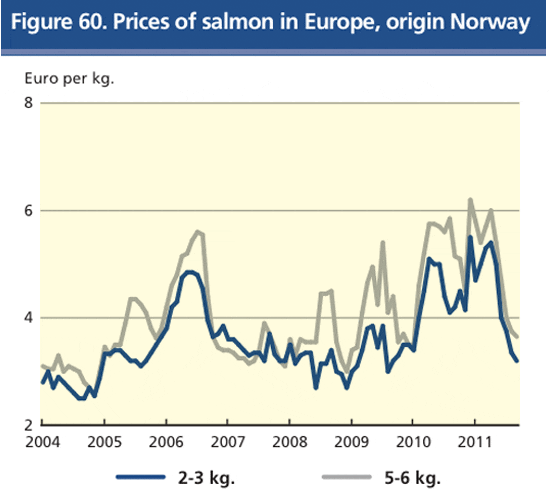
The majority of consumers and producers are still found in Mediterranean countries, but sales have become promising in northern markets such as Germany, the Russian Federation and the United Kingdom. United States imports are limited but growing, with Greek shipments of fresh bass alone reaching 692 tonnes during the first six months of 2011, up 78 per cent from 2010.
CRASH IN FARMED SALMON MARKET – RECORD PRICES IN EARLY 2011 DROP TO MONEY-LOSING LEVELS IN NO TIME
The first five months of 2011 were characterised by exceptionally high prices on farmed Atlantic salmon. Producers reaped tremendous margins, but processors and smokehouses that were not able to pass on the full price increases to their customers saw losses grow. Since then, prices have collapsed. Prices started weakening in early May and have not stabilised yet, with buyers unwilling to commit for large volumes, even at current levels. A number of causes contributed to the sudden price drop. The comeback of Chilean products onto world markets in 2011 was one factor. Also, plentiful catches of wild Pacific salmon supplied to the Russian Federation and the United States domestic markets contributed to weaker prices and lower import volumes. During November and December, the market is expected to correct due to seasonal demand. But from mid- 2012, with new production coming to market from both Chile and Norway, prices could easily fall to very low levels.
Chilean salmon exports are staging a comeback this year after a difficult 2009 and 2010, and Chile is targeting its traditional markets of Japan and the United States, to gain back old customers. The fresh market in Brazil remains promising but the recent drop in the Brazilian real is hurting Chilean exporters. Norway’s exports for the first nine months showed a three per cent increase in volumes to 670,000 tonnes. As a result of the sharply lower prices from the third quarter onwards, the value of exports declined, albeit only marginally, to USD 3.9 billion. For the United Kingdom, the largest EU salmon producer, the United State has become its biggest market, followed by France. This is likely to change, as more products from Chile are becoming available in the United States. The United Kingdom has benefitted from Norway’s problems in China, with the United Kingdom’s exports to China increasing from zero to 2,000 tonnes during the first six months of 2011.
French consumption and imports of salmon rose only marginally during the first six months. A big jump came in frozen fillet imports from China, for the most part Pacific salmon of Alaskan and Russian origin. In only two years, frozen fillets have risen by 46 per cent, and are now 21 per cent of total salmon imports, up from 16 per cent during the same period in 2009. United States import volumes are down for the second reporting period in a row. Chile is back as supplier of fresh fillets, but volumes are still below 2009 figures. As a result, Norwegian exporters seem to be withdrawing from the United States fresh fillet market. In Japan, Chilean shipments were up 26 per cent during the period, boosting Japan’s overall salmon imports by 22 per cent during the period to reach 85 900 tonnes.
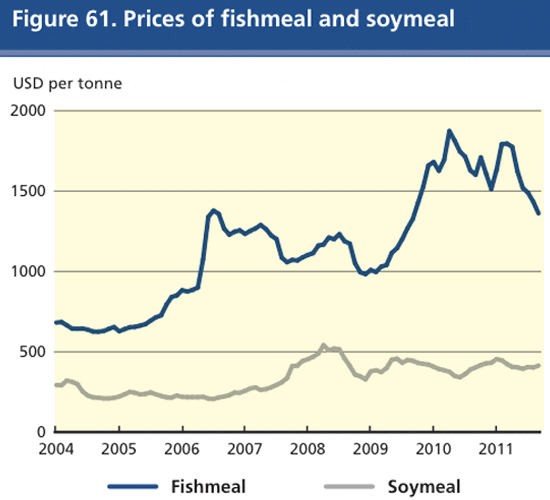
BIG PRICES FOR SMALL PELAGICS
Lower mackerel landings boost pricesThe Norwegian mackerel season had a slow start this year, and in Spain, where 90 per cent of the quota for 2011 has been caught, the national mackerel fishery has been closed. This contributes to the tighter supply situation, as Chile’s mackerel landings are also down considerably. By the end of September, Norway had exported 129,000 tonnes of mackerel worth USD 300 million which represented a decrease of 47,000 tonnes and USD five million from the same period in 2010. China has become Norway’s largest market. From January–September, China imported 32 000 tonnes of frozen mackerel from Norway, followed by Japan (25 900 tonnes) and Russian Federation (14,400 tonnes). Prices are up significantly with Norwegian export prices for round frozen mackerel during the first nine months of the year at Norwegian Kroner (NOK) 14 per kg, 40 per cent higher than last year. Supplies are expected to increase during the rest of the year, and prices to come down a little. An important change is taking place in the utilisation of the Icelandic mackerel. Today, 90 per cent of Iceland’s catches reportedly go for direct human consumption, compared with 2009 when 80 per cent of catches were used for fishmeal and oil production.
Supplies of herring are well below last year’s levels, boosting pricesNorway, the most important herring supplier, exported 203,500 tonnes during the first nine months of the year, down 28 per cent. Russian Federation remains the largest market with 47,900 tonnes, followed by Nigeria (45,000 tonnes) and Ukraine (39 300 tonnes). The Russian Federation catches are also down substantially with total landings down 37 per cent at the end of July, to 172,100 tonnes. As for mackerel, current prices are high with the average export price of frozen Norwegian herring during the first nine months of the year at USD 1.15 per kg, up 53 per cent. The Japanese herring market is relatively stable with imports at 23,000 tonnes during the first half of the year. The United States is by far its largest supplier, accounting for 16800 tonnes or 73 per cent of the total.
Market growth for canned small pelagic in non- traditional marketsPeru is reporting strong buying interest for canned sardines, mackerel and horse mackerel from Brazil, Chile, Ecuador, Japan, the Republic of Korea, Thailand, the United States and the Middle East. The Brazilian market for canned sardines is growing by 7.5 per cent per year. Strong increases in imports led Brazil to impose a ban on imports of Peruvian sardines and anchovy earlier this year, claiming quality problems. European imports of canned sardines are declining, in particular in Germany and the United Kingdom, but the French market is also down. The main suppliers are Morocco and Portugal.
FISH MEAL PRICES REMAIN HIGH IN QUIET MARKET AS OPERATORS AWAIT QUOTAS FOR NEW FISHING SEASON IN PERU
With the quotas for the new season in Chile and Peru still not set, buyers are unwilling to commit but most are well covered for immediate needs. Quotas are expected to be at the same level as last year. Total fishmeal production in the five major reporting countries of the International Fishmeal and Fish Oil Organisation (IFFO) during the first six months of the year showed unchanged volumes of 1.6 million tonnes, the same as in 2010. However, there were significant changes among the producing areas, with South American production rising 21 per cent thanks to a recovery of catches following the 2010 El Niño year. In Northern Europe, the situation was quite the opposite, with production falling 51 per cent because of somewhat lower catches, but more importantly, a higher share of catches going to direct human consumption.
Figure 61Despite some recent softening, prices remain at fairly high levels historically. On the demand side, there is growing uncertainty, given the economic slowdown in many large importing countries. Somewhat further weakening of prices could therefore become apparent in the next six months.
Despite increased production, fish oil exports from Chile and Peru were only marginally higher in first half of 2011With the recovery of the Chilean salmon industry, Chile’s need for fish oil is increasing substantially after a difficult 2009–2010 period. As a result, Peru’s exports to Chile have grown during 2011 with Chile now being the largest market for Peruvian oil exports. As for fishmeal, the long- term outlook is positive as demand from aquaculture and terrestrial animal production is expected to grow strongly. For fish oil in particular, the demand for omega 3 and oil as dietary supplements will drive up prices. In the short term, prices will depend on the new catch quotas in Chile and Peru, the rate of recovery in the Chilean salmon industry and the overall demand for both marine aquaculture and dietary supplements.
November 2011

